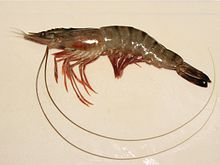Family of crustaceans
.mw-parser-output .hidden-begin{box-sizing:border-box;width:100%;padding:5px;border:none;font-size:95%}.mw-parser-output .hidden-title{font-weight:bold;line-height:1.6;text-align:left}.mw-parser-output .hidden-content{text-align:left}You can help expand this article with text translated from
the corresponding article in Japanese. (September 2020) Click [show] for important translation instructions.
Machine translation, like
DeepL or
Google Translate, is a useful starting point for translations, but translators must revise errors as necessary and confirm that the translation is accurate, rather than simply copy-pasting machine-translated text into the English Wikipedia.
Consider
adding a topic to this template: there are already 3,792 articles in the
main category, and specifying|topic= will aid in categorization.
Do not translate text that appears unreliable or low-quality. If possible, verify the text with references provided in the foreign-language article.
You must provide
copyright attribution in the
edit summary accompanying your translation by providing an
interlanguage link to the source of your translation. A model attribution edit summary is Content in this edit is translated from the existing Japanese Wikipedia article at [[:ja:クルマエビ科]]; see its history for attribution.
You should also add the template ((Translated|ja|クルマエビ科)) to the
talk page.
For more guidance, see
Wikipedia:Translation.
Penaeidae is a family of marine crustaceans in the suborder Dendrobranchiata, which are often referred to as penaeid shrimp or penaeid prawns. The Penaeidae contain many species of economic importance, such as the tiger prawn, whiteleg shrimp, Atlantic white shrimp, and Indian prawn. Many prawns are the subject of commercial fishery, and farming, both in marine settings, and in freshwater farms. Lateral line–like sense organs on the antennae have been reported in some species of Penaeidae.[1] At 210 metres per second (760 km/h), the myelinated giant interneurons of pelagic penaeid shrimp have the world record for impulse conduction speed in any animal.[2]
Genera
Of the 48 recognised genera in the family Penaeidae, 23 are known only from the fossil record (marked †):[3]
- † Albertoppelia Schweigert & Garassino, 2004
- † Ambilobeia Garassino & Pasini, 2002
- † Antrimpos Münster, 1839
- Artemesia Bate, 1888
- Atypopenaeus Alcock, 1905
- † Bombur Münster, 1839
- † Bylgia Münster, 1839
- † Carinacaris Garassino, 1994
- † Cretapenaeus Garassino, Pasini & Dutheil, 2006
- † Drobna Münster, 1839
- † Dusa Münster, 1839
- Farfantepenaeus Burukovsky, 1997
- Fenneropenaeus Pérez Farfante, 1969
- Funchalia Johnson, 1868
- † Hakelocaris Garassino, 1994
- Heteropenaeus De Man, 1896
- † Ifasya Garassino & Teruzzi, 1995
- † Koelga Münster, 1839
- † Libanocaris Garassino, 1994
- Litopenaeus Pérez Farfante, 1969
- † Longichela Garassino & Teruzzi, 1993
- † Longitergite Garassino & Teruzzi, 1996
- † Macropenaeus Garassino, 1994
- Macropetasma Stebbing, 1914
- Marsupenaeus Tirmizi, 1971
- Megokris Pérez Farfante & Kensley, 1997
- Melicertus Rafinesque, 1814
- Metapenaeopsis Bouvier, 1905
- Metapenaeus Wood-Mason & Alcock, 1891
- † Microchela Garassino, 1994
- † Micropenaeus Bravi & Garassino, 1998
- Parapenaeopsis Alcock, 1901
- Parapenaeus Smith, 1885
- Pelagopenaeus Pérez Farfante & Kensley, 1997
- Penaeopsis Bate, 1881
- Penaeus Fabricius, 1798
- Protrachypene Burkenroad, 1934
- † Pseudobombur Secretan, 1975
- † Pseudodusa Schweigert & Garassino, 2004
- † Rauna Münster, 1839
- † Rhodanicaris Van Straelen, 1924
- Rimapenaeus Pérez Farfante & Kensley, 1997
- † Satyrocaris Garassino & Teruzzi, 1993
- Tanypenaeus Pérez Farfante, 1972
- Trachypenaeopsis Burkenroad, 1934
- Trachypenaeus Alcock, 1901
- Trachysalambria Burkenroad, 1934
- Xiphopenaeus Smith, 1869
